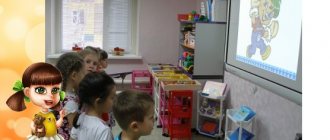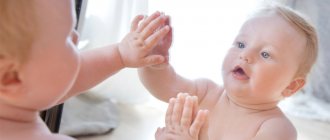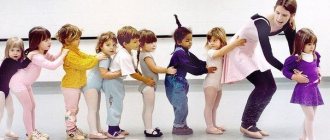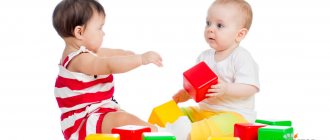Gun actions
In the second year of life, objective activities again undergo some changes. They acquire a new quality. Actions become objective and specifically human, based on the ways of using certain things developed in culture. They are called guns.
How are these actions formed? By the end of the first year of life, the child begins to increasingly encounter those objects that are associated with the everyday life of adults. This could be a comb or spoon, toothbrush, etc. Actions with them are called instrumental. That is, they involve performing certain manipulations and obtaining a substantive result of activity in the form of achieving the necessary goal. This can be drawing with a brush, chalk or pencil. This also includes turning the key to operate the winding machine. At the same time, objective play activity also develops when children pour sand into a bucket with a scoop, hammer pegs into the holes of a board or into the ground, etc.
Subject activity at an early age
We will help you write any paper on a similar topic.
- Essay
From 250 rub.
- Test
From 250 rub.
- Course work
From 700 rub.
Receive completed work or specialist advice on your educational project
Find out the cost
Among the important new formations
early childhood include
the child's mastery of objective activities
. Its prerequisites were formed in infancy.
Subject activity
- leading early childhood activities. Objective activity is leading because it is in it that the development of all aspects of the child’s psyche and personality occurs. The transition to object-based activity is associated with the development of a new attitude in the preschooler to the world of objects.
The child’s objective activity, which arises at the turn of infancy and early childhood, consists of mastering and performing objective actions
. Objects begin to appear to him not only as objects convenient for manipulation, but also as things that have a specific purpose and a specific way of use.
Understanding the purpose of the subject
does not guarantee that the child will use it only for its intended purpose, but the important thing is that he will know how, when and where it should be done. For example, having learned that pencils are needed for writing and drawing, a child can nevertheless roll them around the table or build something with them.
At first, the action and the object are closely related in the child’s understanding. An example of this is the following fact: he cannot comb his hair with a stick or drink from a cube. But over time, the subject is separated from the action.
There are three phases in the development of the connection between an action and an object
:
1) any actions can be performed with the object;
2) the item is used only for its intended purpose;
3) free use of an object is possible, but only if its true purpose is known.
Opening the purpose of items
and
distinguishes the objective activity
of a young child
from the manipulative activity
of an infant.
Functions of things and objects
adult
opens it to the child . It is he, the adult, who can provide knowledge about the purpose of objects and show techniques for their use, participating in the child’s activities as an organizer, assistant and senior partner. An important role in mastering subject activity belongs to business communication, which contributes to the fact that subject activity acquires leading status at an early age.
In the formation of independent subject activity
a child, as research by S. L. Novoselova (1978) has shown, three stages can be distinguished.
First stage
- these are
objective manipulations
of children of 5-6 months, which turn into indicative actions by 7-9 months.
By the end of 1st year
In life, these actions become
subject-specific
(
second stage
). They differ from manipulations with the ball (grabbing, holding, squeezing, gnawing) and indicative (rhythmic squeezing, circular licking, finger pressure, repeated throwing), rolling the ball or hitting the ball hard on the floor (to make it jump) - these are already actions aimed to obtain a certain result. Gradually, the child masters the correct actions with objects - he rolls a ball, pushes a car, puts a doll on the bed, assembles and disassembles a pyramid.
Third stage
associated with the emergence of
object-mediated actions
, which are carried out by instrumental operations (children at the beginning of the second year eat with a spoon; use strollers to roll dolls, trucks to transport cubes).
D.B. Elkonin identified two directions for the development of substantive activity
:
1. Development of action from joint with an adult to independent execution
.
At first, the orientation, execution and evaluation of the action are under the control of the adult. This manifests itself, for example, in the fact that an adult takes the child’s hands and performs actions with them. Then a partial or joint action is performed, i.e. the adult begins it, and the child continues. Then the action is performed on the basis of demonstration and, finally, on the basis of verbal instructions.
2. Development of means and methods of orienting the child in the context of the action
.
It goes through several stages.
First stage
consists of:
a) in the non-specific use of tools (manipulation of objects);
b) using an object when the methods of its use have not yet been formed, for example, a child understands what a spoon is for, but when eating he takes it very low;
c) mastering a specific method of use.
Second phase
occurs when the child begins to perform actions in an inadequate situation. In other words, the action is transferred from one object to another, for example, a child, having learned to drink from a mug, drinks from a glass. There is also a transfer of action according to the situation, for example, having learned to put on shoes, the child tries to pull them on the ball.
Third stage
accompanied by the emergence of game action. Here the adult does not tell the child what to do, how to play or use an object.
Gradually, the child begins to correlate the properties of objects with operations, that is, he learns to determine what an object can best do, which operations are most suitable for a specific object.
The stages of formation of such fastenings were identified by P.Ya. Galperin. He believed that in the first stage
the child varies his actions based not on the properties of the tool with which he wants to get the object he needs, but on the properties of the object itself.
He called this stage “ targeted trials
.”
At the second stage
- “
lying in wait
” - the child finds an effective way of acting with an object and tries to repeat it.
At the third stage
- the “
obsessive intervention stage
” - he tries to reproduce an effective method of influence and master it; at
the fourth stage
he discovers ways to regulate and change the action, taking into account the conditions in which it will have to be performed.
Formation of substantive actions
is closely related
to changes in the nature of the child’s orienting activity
.
On the first steps
In the development of objective activity,
the object and the action are closely related to each other
: the child performs the learned action only with the object that is intended for this. For example, in studies by E.I. Kislenko, two-year-old children were asked to perform the following actions with a handkerchief: use it for its intended purpose, as a towel, napkin or rag for wiping the table. Children sought to use the handkerchief for its functional purpose: 95% of children did not allow the possibility of using it in any other capacity.
is gradually separated from the subject
.
As the child masters the subject activity, the nature of the child’s orientation when meeting a new subject changes. If an infant acts with a familiar object in all the ways known to him, then the early child finds out what this object is for and how it can be used. Orientation like “What is it?
” is replaced by an orientation like “What can be done with this?” From the first half of the second year of life, children begin to perform actions with toys that they observe in adults:
Kids put the doll to bed, feed it, take it for a walk, push a car, push a stroller, wash it, clean household items, cook, do laundry, etc.
Correlative and instrumental actions are significant for mental development.
Correlating Actions
consist of bringing several objects into certain spatial interactions - for example, folding pyramids from rings, using collapsible toys, etc.
Correlating Actions
require
taking into account the size, shape, location of various objects
.
Initially, the baby can perform these actions only through practical trials.
, because he does not yet know how to visually compare the size and shape of objects.
For example, when placing the lower half of a nesting doll on the upper one, he discovers that it does not fit and begins to try another. Sometimes he tries to achieve a result by force - to squeeze in inappropriate parts, but soon becomes convinced of the inconsistency of these attempts and proceeds to try on and try out different parts until he finds the right part. From external indicative actions, the baby moves on to visual correlation
of the properties of objects. This ability is manifested in the fact that the child selects the necessary details by eye and performs the correct action immediately, without preliminary practical tests. He can, for example, select rings or cups of the same or different sizes.
In the second year of life and throughout early childhood, a special type of action
with
objects, based on their use in accordance with cultural purpose
.
The baby tries to eat with a spoon, comb his hair with a comb, dig sand with a spatula, insert a key into the car, trying to start it, etc. Psychologists call such actions instrumental
, since they involve the impact of one object on another to achieve a certain result.
The tool acts as an intermediary between the child’s hand and the objects that need to be influenced, and how this influence occurs depends on the design of the tool. Digging sand with a scoop or scooping up porridge with a spoon is completely different from how you use your hand. Therefore, mastering instrumental actions requires a complete restructuring of the child’s hand movements, their subordination to the structure of the instrument.
The meaning of weapon actions
the child cannot understand on his own, it
is revealed to him by an adult
. And it can be extremely difficult for a child to perform such actions. Therefore, he constantly turns to an adult for help or invites him to play together. The child masters instrumental actions during training with the systematic guidance of an adult who shows the action, guides the child’s hand, and draws his attention to the result.
It was found that instrumental actions can be an indicator of the intellectual development of children, and subject actions indicate the degree of their learning and the breadth of contacts with adults.
By the beginning of the third year of life
objective activity has already been formed, at least in relation to those household items that the child uses.
In the third year of life
The child continues to master the surrounding objective world.
The baby's actions with objects
become
more varied and dexterous
. He already knows how to do a lot himself, knows the names and purposes of household items, and strives to help adults: wash dishes, wipe the table, vacuum the floor, water flowers.
He increasingly consciously wants to act like an adult; he begins to be attracted not only to the process of performing an action, but also to its result.
A child tries to get the same result as an adult. If in the second year of life, imitating his elders, the baby reproduced only the external picture of their actions, for example, sweeping the floor with a broom, leaving garbage around him without paying attention to it, then by the end of his early age the main thing for him becomes getting the right result: now, sweeping the floor, he makes sure it gets clean.
Thus, the child’s attitude towards his activity gradually changes: the result becomes its regulator.
. In independent activities and games, the child begins to be guided by a plan, a desire to achieve success in activities.
Mastery of subject activity
stimulates the development of such
personal qualities of children
as
initiative, independence, determination
.
The child becomes more and more persistent in achieving his goal.
Towards the end of early childhood, play and productive activities arise in object-tool activity.
Attention!
If you need help writing a paper, we recommend turning to professionals. More than 70,000 authors are ready to help you right now. Free adjustments and improvements. Find out the cost of your work.
Cost calculationGuaranteesReviews
Indicative actions
There are three stages in the development of objective activity. The first of them is observed in babies 5-6 months old. This stage represents subject manipulations. By 7-9 months they are transformed into indicative actions.
At first, all manipulations with objects in a child are carried out without considering their properties. The baby treats whatever comes into his hands equally. He sucks on a toy or any other object, waves it, taps it, etc. At the same time, he also examines what is in his hands, moves it from place to place and repeatedly repeats the same movement. And only a little later he begins to develop specific manipulations. The child not only notices, but also uses the features of objects, their most simple properties. An example of such indicative actions is stacking one object on top of another, threading a toy through the bars of the playpen. Babies also love to crumple paper and rattle with rattles. Moreover, their attention is attracted by objects created not only by man, but also by nature - sand, pebbles, water, etc.
The subject activity developing at this stage is one of the options for exploratory behavior, which manifests itself thanks to the child’s curiosity and his cognitive activity. By conducting experiments on objects in the surrounding world, the baby extracts information about them and learns to establish existing connections.
Exploratory behavior begins to develop most intensively after a little person learns to move independently, gaining access to various objects. And here the child’s communication with adults is especially important. They are entrusted with the task of organizing the child’s objective activities. Adults must create the environment necessary for the development of a little person, attract his attention to new objects, support and encourage his curiosity.
During early childhood, exploratory behavior is constantly improving. At the same time, it remains one of the most important components of creative and cognitive development not only during this period, but also in the future. By experimenting, the child gets real pleasure. He begins to feel like a subject of ongoing events and a source that caused changes in the surrounding reality.
Correlating Actions
By the end of the first year of life, the child’s activity in relation to objects in the surrounding world takes on a slightly different character. His objective-practical activity is based on using things for their intended purpose. An adult shows the child how to deal with them. Imitating him, the child begins to assemble pyramids, build towers from cubes, etc.
At this level, objective activity is no longer isolated actions with various objects. After all, they are performed with objects when they interact with each other. Such manipulations are called correlative. The child conducts various experiments with objects and determines the connections that exist between them.
Article:
In connection with the mastery of objective activities, the nature of the child’s orientation in situations that are new to him, when meeting new objects, changes.
If during the period of manipulation a child, having received an unfamiliar object, acts with it in all ways known to him, then subsequently his orientation is aimed at finding out what this object is for and how it can be used. Orientation like “what is it?” is replaced by an orientation like “what can be done about this?” Among the actions that a child masters in early childhood, correlative and instrumental actions are especially significant for his mental development. Correlating are actions whose purpose is to bring two or more objects (or their parts) into certain spatial relationships. This, for example, is folding pyramids from rings, using all sorts of collapsible toys, closing boxes with lids.
By the end of early childhood (in the third year of life), new types of activities begin to take shape, which reach expanded forms beyond this age and begin to determine mental development. This is a game and productive activities (drawing, modeling, designing). During preschool childhood, play becomes the leading activity, but not because the child, as a rule, spends most of his time in games that entertain him - play causes qualitative changes in the child’s psyche. The actual play action will occur when the child means another by one action, and another by one object. The game action is of a familiar (symbolic) nature. It is in play that the formulated sign function of the child’s consciousness is most clearly revealed. Its manifestation in the game has its own characteristics: game substitutes for objects may have significantly less resemblance to the objects themselves than, for example, a drawing with the reality depicted. However, game substitutes should allow you to act with them in the same way as with the replaced item. Therefore, by giving his name to the chosen substitute object and attributing certain properties to it, the child also takes into account some of the features of the substitute object itself. When choosing substitute objects, the preschooler proceeds from the real relationships of the objects. He readily agrees that half a match will be a bear, a whole match will be a mother bear, and a box will be a bed for a bear. But he will never accept this option, where the teddy bear is a box, and the bed is a match.
In play activities, the preschooler not only replaces objects, but also takes on one or another role and begins to act in accordance with this role. A child can take on the role of a horse or a terrible beast, but most often he portrays adults - a mother, a teacher, a driver, a pilot. In play, the child discovers for the first time the relationships that develop between people in the process of work, their rights and responsibilities.
In role play, children reflect the diversity of reality around them. They reproduce scenes from family life, work activities and relationships between adults. The reality reflected in children's games becomes the plot of a role-playing game. Children of different age groups, playing a game with the same plot, bring different content to it. Thus, younger preschoolers repeatedly repeat the same actions with the same objects, reproducing the real actions of adults. The game plot, as well as the game role, is most often not planned by the child of primary preschool age, but arises depending on what object falls into his hands. The content of the role-playing game for older preschoolers is subject to the rules arising from the role taken on.
In play activities, certain forms of communication between children develop. The game requires from the child such qualities as initiative, sociability, and the ability to coordinate his actions with the actions of a group of peers in order to establish and maintain communication.
With the development of gaming skills and the complication of game plans, children begin to engage in longer-term communication. The game itself demands this and promotes this. In playing together, children learn the language of communication, mutual understanding and mutual assistance, and learn to coordinate their actions with the actions of others. Gaming activity influences the formation of arbitrariness of mental processes. Thus, in play, children begin to develop voluntary attention and voluntary memory. Role-playing play is crucial for the development of imagination. In play activities, the child learns to replace some objects with others and take on different roles. By capturing the child and forcing him to obey the rules corresponding to the role he has assumed, the game contributes to the development of feelings and volitional regulation of behavior.
Productive activities of the child - drawing, design - at different stages of preschool childhood are closely merged with play. Interest in drawing and design initially arises precisely as a game, aimed at the process of creating a drawing or design in accordance with the game plan. And only in middle and senior preschool age is interest transferred to the result of the activity (for example, drawing), and it is freed from the influence of the game. Within the gaming activity, educational activity also begins to take shape, which later becomes the leading activity.
Stages of development of subject activity
The process of developing skills to perform objective actions is not immediate and quick. It requires a certain amount of time and competent training. Subject activity goes through several stages of development:
- The first stage is performing manipulations with objects. It covers the age period of 5-6 months of the child. It is characterized by simple manipulation of objects, without awareness of their real purpose and functional role, and also without a focus on achieving a specific result. At 7-8 months, manipulation turns into indicative actions. In fact, the child still cannot perform objective actions.
- The second stage is the implementation of subject-specific actions. Such actions already have a more conscious meaning. It is performed for something i.e. are aimed at obtaining some effect from their implementation. At the same time, the child is already learning and begins to realize the need for proper interaction with this or that object. The age period for passing the stage is the second year of life. The child already highlights some features of objects, without placing emphasis on the significance and degree of importance of each of them.
- The third stage is the implementation of object-mediated actions. This is where instrumental tasks and processes are carried out. The child no longer simply performs his actions, but understands what tools and instruments can be used to implement them, i.e. he understands that his teeth need to be brushed with a toothbrush, dripped with a shovel, and eaten from a plate. During this period, general concepts begin to form in the child’s mind.
When mastering objective actions, the child initially learns only the close connection of the object with its immediate purpose. He cannot imagine its use in another capacity and in another direction of activity. Action and object are in close relationship with each other in the child’s mind. For example, a child cannot imagine how a napkin can be used not for wiping hands, but as a doormat.
Subsequently, the direction of the child’s objective actions develops and expands. He masters the purpose of objects and options for their practical use.
With the growth and development of the child, objective actions acquire the character of instrumental ones, i.e. objects begin to be used as tools for performing some actions.
Note 2
Subject activity skills are fully developed at the age of three.
Conditions for effective teaching of subject activities
Since objective activity is very important for the development of a child’s personality, his consciousness and thinking, its organization is given a significant place. In order for the process of learning to interact with objects to be effective, the following conditions for its formation must be observed:
- Start with a small number of objects, gradually increasing it and creating conditions for the child to be interested in them, their use and options for actions with them;
- The formation of objective actions should be step-by-step in nature and carried out through direct interaction and cooperation with the child;
- To develop activity, independence, curiosity, and the child’s initiative in performing actions with objects;
- An adult must show tolerance and restraint, not impose his opinion on the child, giving him the opportunity to choose and be active in activities.
Get paid for your student work
Coursework, abstracts or other works






